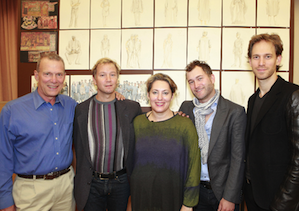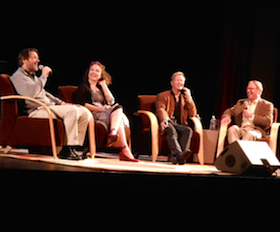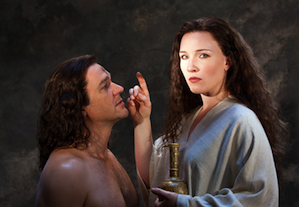
Photo by Henry Fair
Now that Dan Brown's symbolist sleuth Robert Langdon is chasing clues of the Inferno, it's possible to forget that before Brown's The Da Vinci Code, Edgar Saltus' 1891 Mary Magdalene: a Chronicle Gospel of Luke, Mary Magdalene, and the Drama of Saints: Theatre, Gender, and Religion in Late Medieval England, following up Ann Graham Brock's Mary Magdalene, the First Apostle: The Struggle for Authority and Katherine Ludwig Jansen's The Making of Magdalene: Preaching and Popular Devotion in the Later Middle Ages have all remained matters of academic interest only.
As to the official Church of Rome status, Pope Benedict XVI's 2010 book for children, Friends of Jesus, unceremoniously omitted Mary, apparently still regarding her as someone too controversial.
But then there was Brown's bestseller, with 81 million copies, double what Jonathan Livingston Seagull accomplished in 40 years — and the film, defying horrendous reviews (165 negative ones of the 214 counted) brought in $750 million. Now, Mark Adamo's opera is about to open in the War Memorial, for a run from June 19 through July 7, and John Adams' take on the subject is getting performances around the world.
Before Brown, outside a limited amount of religious scholarship, Mary was known only as one of Jesus' disciples, the only woman among them, who was present — significantly — at both of the New Testament's most important moments: the Crucifixion and the Resurrection. She was even said to be the first witness of Jesus' rising.
In Brown's novelistic version, disputed by most scholars, Mary is also represented as royalty, the writer of The Gospel of Mary, smeared by the early Church, and also intended by Jesus to lead the Church.

Photo by Cory Weaver
At a panel discussion Sunday evening in the Jewish Community Center of San Francisco, the composer, principal cast members Sasha Cooke (Mary Magdalene) and Nathan Gunn (Yeshua) discussed the opera, not shying away from the many religious controversies inherent in the subject. SFO Director of Music Administration Kip Cranna moderated the discussion.
Right up on top of the libretto, it says: "Adapted from the texts of, and research on, the Canonical and Gnostic Gospels." Following quotes from Wagner and Emerson, there is this from J.S. Spong, a retired American Episcopelian bishop, who has been calling for a fundamental rethinking of Christian belief, "away from theism and traditional doctrines."
Why is there still a continuing sense, ranging from unease to revulsion, that arises in us when we hear the suggestion that Jesus might have been married? I suggest that far more than any of us realize, we are subconsciously victimized by the historic negativity toward women that has been a major gift of the Christian church to the world.
Adamo told the well-filled hall at the JCC that in creating the libretto, "with 120 footnotes," and giving interviews, he has reached the state of "not being a Biblical scholar, but I play one on the radio." In swift flights of historic and scholarly narration, he exhibited impressive knowledge of the subject, and acknowledged his intention to free the material "from orthodoxies."
A large production in an opera house, Adamo said, is "a safe place to talk about dangerous things."

Photo by Janos Gereben
Adamo, raised as a Catholic, but open and comfortable in the (welcoming) atmosphere of the JCC, was emphatic and passionate about a work denouncing "the negativity towards sex and women that poisons [the canonical gospel] tradition ... the sacrality [sic] of erotic love." To applause evoked by his committed passion, Adamo said he will "not shy away" from presenting Yeshua (Jesus' Hebrew name) and Mary Magdalene in a love scene, where she says:
I can tell you what I’ve learned from you.
About how to live;
About giving and receiving love,
And how it’s better to give;
About how love is not the same thing as desire,
And how desire can lie. But—
I can’t say I don’t desire you.
And I won’t try.
In the opera's Prolegomenon (a preliminary discussion rather than a prologue), there is a montage of news coverage (reminiscent of Nixon in China) in 1948 as the Nag Hammadi scrolls — found three years before — are first published, telling radically different stories from the canononized (and later) New Testament versions. These came after finding Coptic texts of the Greek originals of the Gnostic Gospel of Thomas.
Adamo presents scenes of love affairs where Mary seeks meaning, not acting as a prostitute, a sin she was accused of for centuries until finally, in 1969, any mention of her as a sinner was omitted from Roman Catholic liturgical materials. (Still no "friend," according to Pope Benedict.)
Among numerous lectures and events in advance of the opera premiere, on Sunday, June 9, beginning at 9:30 a.m., Grace Cathedral will host a conversation with Adamo and Cooke, hosted by the Very Rev. Dr. Jane Shaw. The free forum is presented in partnership with San Francisco Opera.

